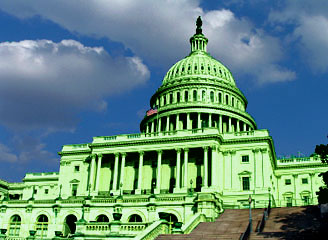There’s been a deluge of bills on climate and energy introduced in Congress in the past few weeks.
But the most notable news is that Congress is likely to omit a climate program from the budget resolution.
President Obama’s budget proposal included a cap-and-trade plan to reduce greenhouse-gas emissions, but the House and Senate budget committees are not following his lead. In both the House [PDF] and Senate [PDF] budget resolutions released on Wednesday, cap-and-trade is nowhere to be seen. The legislators did, however, include placeholder language that will allow them to create a “reserve fund” that can be used for clean energy development, and left their options open for a separate cap-and-trade bill down the line.
Speaking in a press conference with reporters on Wednesday, Office of Management and Budget Director Peter Orszag struck an optimistic note about this discrepancy. “The fact that it’s not treated in the budget resolution the same way that we proposed in no way means that the House and Senate can’t take the legislation up,” said Orszag. “In fact, I think some may argue that the political economy of getting climate change done this year may actually be better outside of the budget resolution than inside of it.”
In other legislative news:
• This week, Rep. Jim McDermott (D-Wash.) introduced a climate bill aimed at cutting greenhouse-gas emissions 80 percent by 2050. Under his plan, polluters would buy emission permits but would not be able to trade them. The Treasury Department would set the price, and that price would rise as the number of available permits declined. Revenues from sale of the permits would go into a trust fund, which could be used to compensate consumers for increased energy costs or support clean energy projects, though the bill doesn’t specify how the funds would be spent.
• Last week, Rep. Chris Van Hollen (D-Md.) introduced the National Home Energy Savings Revolving Fund Act, which would create a $10 billion fund for local governments to provide homeowners with up to $10,000 in zero-interest loans for making home energy-efficiency improvements. He estimates it could help retrofit one million households.
• Van Hollen also released a bill on Tuesday that would create a national Green Bank to fund a variety of clean-energy and efficiency projects. The bank would be an independent, tax-exempt corporation of the federal government, and would issue $10 billion in “green bonds” through the Department of Treasury each year.
• Sen. Jeff Bingaman (D-N.M.) introduced the Restoring America’s Manufacturing Leadership and Energy Efficiency Act. The bill would provide loans to help manufacturers start using more energy-efficient equipment and processes, and create government partnerships with industry to develop and deploy new efficient technologies.
• Bingaman and Sen. Lisa Murkowski (R-Alaska) introduced the Appliance Standards Improvement Act, which would update the Department of Energy’s appliance standards program and the federal Energy Star program. This bill has already created controversy, as it includes measures to address problems at the EPA and DOE that Obama officials say they’re already working on.
• Reps. Lloyd Doggett (D-Texas) and Jim Cooper (D-Tenn.) introduced the Safe Markets Development Act on Monday, which would guide the auction of carbon credits to polluters. This isn’t a complete cap-and-trade bill, but it covers the credit allowance portion of a cap-and-trade program and could be attached to a larger climate bill. Their measure would create an independent board — made up of climate experts, the EPA administrator, and the secretaries of energy and treasury — that would set the price of carbon credits in order to meet emission-reduction goals between 2012 and 2020. The Treasury Department would conduct quarterly allowance auctions based on those prices, and the board would hold annual reviews to make sure the emission-reduction goals are being met.


